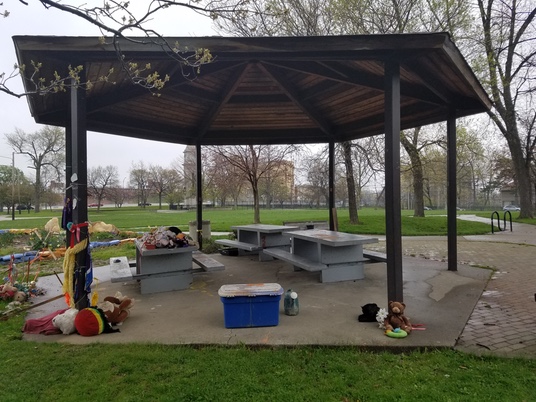
The City of Cleveland made enough mistakes in the Tamir Rice case to fill a textbook on what not to do in response to a tragic killing. From hiring a seriously flawed individual like Timothy Loehmann in the first place (and giving him a badge and gun), to blaming a 12-year-old child for his own death, the bungling of this tragic crime and its aftermath has ascended to monumental proportions. And it could get worse; there could be yet another slap in the face of the collective Rice family in the making.
The Smithsonian’s Museum of African American History and Culture initially stated, in an email last week to Cleveland Law Director Barbara Langhenry, that the museum — at the behest of members of the Black Lives Matter movement — wanted to preserve the gazebo where Tamir was fatally shot. However, the next day officials quickly back away from that position.
“It sounds that way [that the museum wanted the gazebo] but that’s just not the case,” said LaFleur Paysour, a media specialist for the museum. “We are not looking at that as something that we want to preserve.” Which leaves one to wonder whom in the museum hierarchy instructed her to make that statement.
But simply because this one museum doesn’t want the gazebo doesn’t mean that it’s not worth preserving, a sentiment I’m sure some will disagree with. Many entities — city governments included — want to, as quickly and quietly as possible, bury their mistakes. To make their errors disappear from the face of the earth, as if the horrific incident never happened. And there certainly are some folks in Cleveland City Hall that are of this frame of mind.
It’s quite understandable that residents of the Cudell neighborhood where the crime took place would want the gazebo gone — too much of a painful reminder of a senseless killing. But avoiding pain should not be the first concern of citizens of the wider society.
This gazebo should be preserved and a proper home found for it in a museum somewhere in the country as a reminder of what can go wrong when bad, thoughtless decisions are made. If we do not learn from — and remember — history, we’re bound to repeat tragic incidents over and over again.
Attorneys for the Rice family want the City of Cleveland to allow them — in the name of the family — to take ownership of the gazebo; to remove it from the park where the killing took place and store it until a proper place can be found to display it. And they have all of the funds in place to do just that. The city had agreed to give the Smithsonian’s Museum of African American History and Culture 30 days to come up with a plan; the Rice family should be accorded the same 30 days.
But certain forces within the city want the gazebo destroyed, and they’ve gotten engineers and architects on board saying that it cannot be deconstructed; that it cannot be saved; that it has to be broken apart so that it could never be put back together again.
Now, maybe the folks who rendered this political opinion don’t know how to deconstruct it, but that doesn’t mean that some other more talented folks can’t do it. I visited the park, examined the gazebo and took photos. It’s really not that complicated a job at all to disassemble the structure and cart it off to a storage facility. In fact, it’s a piece of cake. Why wouldn’t the city allow someone else to do the job their “experts” say can’t be done? It won’t cost taxpayers one thin dime.
Excuse me for my suspicions, but in spite of the fact people high up in City Hall gave me assurances that there was no rush to tear the gazebo down, I remain concerned, given all of the bungling that has transpired in this case so far, that some city crew will tear the structure down under dark of night and then blame it on a miscommunication. I sincerely pray this doesn’t occur.
Will the Rice family be allowed to avoid the final indignity of having the gazebo destroyed, or will those who would rather the entire episode be erased entirely from the public memory — so they can, at some point down the historical line, claim the killing never happened — be allowed to triumph?
We shall see.

From Cool Cleveland correspondent Mansfield B. Frazier mansfieldfATgmail.com. Frazier’s From Behind The Wall: Commentary on Crime, Punishment, Race and the Underclass by a Prison Inmate is available again in hardback. Snag your copy and have it signed by the author by visiting http://NeighborhoodSolutionsInc.com.